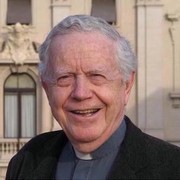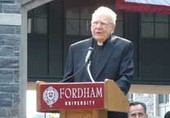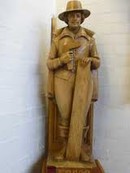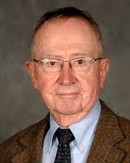Terms: A | B | C | D | E | F | G | H | I | J | K | L | M | N | O | P | Q | R | S | T | U | V | W | X | Y | Z
Jesuit Terms O
O'Collins, Gerald (1931-)
Australian Jesuit; professor of theology at the Gregorian University (Rome) for 33 years; prolific author and defender of human rights in the church

While O'Collins has sometimes taken a traditional or conservative theological position rather than breaking new ground, he has always been open to new ideas. An avid ecumenist and respecter of other religions, he has consistently spoken and acted for human rights in the Catholic church and opposed the imposition of a narrow orthodoxy. In this capacity, he worked closely with his Gregorian colleague Jacques Dupuis when Dupuis was attacked by the Vatican Doctrinal Congregation (Josef Ratzinger).
O'Collins is writing an autobiography; the first of two volumes is titled On the Left Bank of the Tiber (Connor Court, 2013)
Back to top
O'Keefe, Vincent (1920- 2012)
American Jesuit; confidant of Pedro Arrupe as superior general
 O'Keefe was president of Fordham University when in 1965 he went to General Congregation 31. This was the congregation that elected Pedro Arrupe superior general; it elected O'Keefe one of four general counselors, and he remained in that office through the entire Arrupe generalate (1965-1983). When Arrupe was refused permission by John Paul II to retire from office for reasons of age and infirmity and shortly thereafter suffered a debilitating stroke, he appointed O'Keefe vicar general in his place. But the pope removed them both from office and appointed his own delegate to run the Society. Then in less than two years after this papal "intervention," saying that he had been "misinformed," the pope allowed the Jesuits to return to their own governance and elect a new superior general (Peter-Hans Kolvenbach).
O'Keefe was president of Fordham University when in 1965 he went to General Congregation 31. This was the congregation that elected Pedro Arrupe superior general; it elected O'Keefe one of four general counselors, and he remained in that office through the entire Arrupe generalate (1965-1983). When Arrupe was refused permission by John Paul II to retire from office for reasons of age and infirmity and shortly thereafter suffered a debilitating stroke, he appointed O'Keefe vicar general in his place. But the pope removed them both from office and appointed his own delegate to run the Society. Then in less than two years after this papal "intervention," saying that he had been "misinformed," the pope allowed the Jesuits to return to their own governance and elect a new superior general (Peter-Hans Kolvenbach).
O'Malley, John W. (1927-2022)
American Jesuit; historian of early modern and contemporary Catholicism
John O'Malley served many years as a university professor, most reacently in the theology department at Georgetown University. His specialty is the religious culture of early modern Europe, with concentration in Renaissance humanism and the Society of Jesus. He is also interested in Vatican Council II and contemporary Catholicism. His best known work is The First Jesuits (1995), winner of several best-book awards and now translated into ten languages. His recent books include The Jesuits: A History from Ignatius to the Present (2014). The Jesuits and the Popes: a Historical Scetch of Their Relationships (2016), Vatican I: The Council and the Making of the Ultramontane Church (2018). Fourteen U.S. Jesuit universities have given him honorary doctoral degrees. He has also been honored with a Festschrift (Early Modern Catholicism: Essays in Honour of John W. O'Malley, S.J., eds. Kathleen Comerford and Hilmar Pabel [2001]).
See his autobiography in the booklet series Lives of the Georgetown Jesuits.
Old Testament / New Testament
The word testament derives ultimately from the Hebrew and means "covenant," a mutual commitment or treaty between two parties in ancient near eastern culture. It was taken over to refer to the commitment between the Hebrew people and their God, as established on Mt. Sinai.
From a Christian perspective, the Old Testament refers to the works of the Hebrew Bible—legends, histories, laws, prophecy, wisdom writings—that make up the first half of its scripture, whereas the second half, containing the four gospel "portraits" of Jesus and the instructional letters of St. Paul (among others), presents a new covenant with God in Jesus.
Some Christian bibles—Catholic, Orthodox, etc.—contain late Jewish writings (that is, close to the time of Jesus) that are not part of the Hebrew Bible and not accepted by Protestants (as the inspired word of God).
Order
- See Religious Order/Religious Life.
Organizations, Jesuit-Sponsored
- Jesuit Volunteer Corps
About 250 volunteers commit themselves to working with people marginalized by society in the United States and seven other countrires. - Ignatian Lay Volunteer Corps
The IVC, in partnership with hundreds of service sites, provides women and men, aged 50 and older, opportunities to serve others, to address social injustice, and to transform lives. - Jesuit Refugee Service
JRS's mission is to accompany, serve, and defend the rights of refugees and forcibly displaced people. Serving in over 50 countries, with the support of an international office in Rome, JRS provides assistance to refugees in refugee camps, to people displaced within their own country, to asylum seekers in cities, and to those held in detention.
Owen, Nicholas (1550-1606)
English Jesuit brother; builder of secret "priest holes"; martyr, saint
 Nicholas Owen was a carpenter and stonemason and a Jesuit brother. He used his skills to build secret hiding places for Catholic priests who traveled around providing Mass and the sacraments to Catholics in the England of anti-Catholic penal laws, where numerous government agents (bounty-hunters) practiced their art. Since being a Catholic priest in Elizabethan and Jacobean England was punishable by death, Owen saved hundreds of lives with his "priest-holes." He himself was picked up several times and shortly released as "small fish," since he wasn't a priest and his real occupation was unknown. Early on, he traveled with Edmund Campion, later with Henry Garnet, and finally with John Gerard—all well-known Jesuit priests. He was simply known as "Little John."
Nicholas Owen was a carpenter and stonemason and a Jesuit brother. He used his skills to build secret hiding places for Catholic priests who traveled around providing Mass and the sacraments to Catholics in the England of anti-Catholic penal laws, where numerous government agents (bounty-hunters) practiced their art. Since being a Catholic priest in Elizabethan and Jacobean England was punishable by death, Owen saved hundreds of lives with his "priest-holes." He himself was picked up several times and shortly released as "small fish," since he wasn't a priest and his real occupation was unknown. Early on, he traveled with Edmund Campion, later with Henry Garnet, and finally with John Gerard—all well-known Jesuit priests. He was simply known as "Little John."
Eventually, he and his work were discovered, and he was taken to the Tower of London. There he was tortured to make him reveal the locations of his "holes," but he never said a word until he expired from the torture.
JESUIT A TO Z: An expanded version of the publication "Do You Speak Ignatian?"

